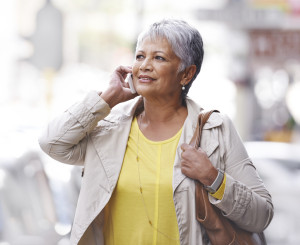AARP Hearing Center
Me and My Smartphone: A Love-Hate Relationship
By Katherine Bouton, April 8, 2015 12:40 PM
For someone with moderate to severe hearing loss, the smartphone is both savior and nemesis. I can’t imagine life without a smartphone, but I can imagine many ways that it could be better.

First the savior aspect: I have at least two and sometimes three ways to communicate using text. The first is email. The second is texting. And the third, when it works, is captioning for telephone calls.
I can also pay for my coffee, go to my gym, download an airplane or theater ticket, take a picture. I can figure out what a 25 percent tip comes to. I can see in an instant what the weather is in Moscow or Kathmandu. I can go on the Internet, I can find out when the subway or bus is coming, I can tweet, Facebook, Instagram and check my stocks. I can read books and magazines, do brain acuity exercises, and I can even measure the decibels in an environment I suspect is too loud.
Get discounts on hearing aids and more with your AARP Member Advantage »
The one thing I can’t do on my phone is talk on it. Yes: The original and by now venerable function of a cellphone as a way for one person to communicate orally with another when not using a landline is the one place where the phone fails me.
I have an iPhone 5S. Even though I bought it less than a year ago, it’s already been superseded by the iPhone 6. I bought the 5S because it had the best reception when paired with my telecoil. But as I discovered, the best isn’t good enough when you really need it.
Last week I was on a moderately busy city street when I saw a man struggling to help another man who was either very ill or very under one influence or another. Or maybe both. I offered to call 911. The street noise drowned out the reception. Even with my telecoil activated, I couldn’t hear a word. I couldn’t even tell if 911 had answered. I handed the phone to another passerby who answered 911’s questions. I could have texted 911, but 911 doesn’t have the capacity to receive texts.
What I need on my cellphone are captions. Accurate captions.
Up until last year, cellphone captioning was provided via an automated voice-recognition system, with imperfect results. In May 2014, the FCC gave Miracon USA Inc. conditional certification as a captioned relay provider, which means it is eligible for reimbursement for the cost of providing captioning services to the deaf and hard of hearing. Miracon introduced the service at the 2014 Hearing Loss Association of America convention.
Miracon’s Innocaption was different from other caption services in that it offered captioning by a human stenographer, rather than an automated voice-recognition system. A well-trained stenographer is both faster and more accurate than a voice-recognition system. InnoCaption users use their own phones to receive or send calls, rather than having to use a special phone. They do need a special telephone number. Impressed by the speed and accuracy of the captions when I tried it out at the convention, I signed up on the spot.
But I found I didn’t use it much. The simultaneous voice and data (captions) don’t work on all phone models and carriers. I had just bought that new iPhone and signed a Verizon Wireless contract when InnoCaption came out. The iPhone/Verizon combination did not allow me to get voice and captions unless I was also within Wi-Fi range. (Here’s a link to a chart showing phone models and providers that provide simultaneous voice and data.)
Like many people, I use my cellphone when I'm not in Wi-Fi range — on the street, say, or in a store, or at a sports event. No Wi-Fi, no captions. I trust the service providers will soon make the upgrades necessary for all smartphones to receive voice and data simultaneously.
In the meantime, unfortunately, InnoCaption is suspending service because of an issue with 911 call handling. The suspension is temporary while the company works with the FCC and a third-party relay service. Cristina Duarte, a spokesperson for InnoCaption, said in an email that they don’t yet know when the service will be working again.
InnoCaption is a promising development in making cellphone use easier for people with hearing loss in noisy environments. The T-coil is a help, and using a streamer with Bluetooth to take the voice directly to your hearing aid is even more of a help. But ambient noise from traffic or background music or babbling voices can still overwhelm the voice on the phone. I hope InnoCaption and the FCC straighten things out quickly.
Providers also need to speed up making simultaneous voice and data universally available—necessary for much more than captions. And the deaf and hard of hearing need the backup of Text 911. My experience last week was a warning. Not being able to contact 911 is a tragedy waiting to happen.
In the meantime I'll make captioned phone calls on my home phone. Those systems have their own plusses and minuses, a subject perhaps for a different post.
Photo: PeopleImages/iStock
Also of Interest
- Cochlear Implants Shown to Reverse Cognitive Decline
- Americas's Best Small Towns
- Get free assistance with tax-return preparation from Tax-Aide
- Join AARP: Savings, resources and news for your well-being
See the AARP home page for deals, savings tips, trivia and more































































